To get your dog on a feeding schedule, start by choosing specific meal times each day. Gradually transition your dog to the new schedule by adjusting their current feeding times.
Establishing a feeding schedule for your dog is essential for their health and well-being. It promotes better digestion, helps maintain a healthy weight, and encourages regular bathroom habits. Dogs thrive on routine, and a consistent schedule can reduce anxiety and improve behavior.
Begin by determining the number of meals your dog needs daily based on their age, size, and activity level. Set fixed times for feeding and stick to them as closely as possible. Over time, your dog will learn to expect meals at those times, making mealtime less stressful for both of you. Creating a feeding schedule is a simple yet effective way to nurture your furry friend.
Table of Contents
ToggleThe Importance Of A Feeding Schedule For Dogs
Establishing a feeding schedule for your dog is crucial. It helps maintain their health and well-being. Regular meal times create a sense of routine. Dogs thrive on consistency, which can improve their overall happiness.
A proper feeding schedule can prevent overeating and obesity. It also ensures your furry friend gets the right nutrition at the right time.
Health Benefits For Your Pooch
Feeding your dog at the same time daily has many health benefits:
- Weight Management: Regular feeding helps prevent obesity.
- Better Digestion: Consistent meal times improve digestion.
- Reduced Risk of Bloat: Scheduled meals can lower bloat risks.
- Optimal Nutrient Absorption: Dogs digest food better with set times.
These health benefits lead to a longer, happier life for your dog.
Behavioral Improvements Linked To Regular Feeding Times
A feeding schedule positively impacts your dog's behavior:
- Reduced Anxiety: Dogs feel secure with a routine.
- Improved Focus: Dogs concentrate better when fed regularly.
- Less Food Guarding: Regular meals decrease food aggression.
- Better Training Outcomes: Consistent meals aid in training sessions.
Establishing a feeding schedule fosters better behavior in your pet.
Assessing Your Dog's Dietary Needs
Understanding your dog's dietary needs is crucial. Proper nutrition supports their health and well-being. A well-planned feeding schedule starts with knowing what your dog requires.
Factors Influencing A Dog's Diet
Several factors affect your dog's dietary needs. Consider these key elements:
- Age: Puppies need more calories and nutrients.
- Size: Larger breeds require more food than smaller ones.
- Activity Level: Active dogs need extra energy.
- Health Conditions: Special diets may be necessary for certain health issues.
- Breed: Some breeds have specific dietary requirements.
Consulting With A Veterinarian
Always consult your veterinarian. They provide expert guidance tailored to your dog. A vet can help determine the right food and portion sizes.
During your visit, discuss:
- Your dog's age and weight.
- Any existing health issues.
- Recommended food types.
- Appropriate feeding frequency.
Veterinarians can also suggest feeding schedules. This ensures your dog receives the right nutrients at the right time.
Choosing The Right Food For Your Dog
Choosing the right food is crucial for your dog's health. A balanced diet helps maintain their energy, coat, and overall well-being. Dogs have different needs based on age, size, and activity level. Understanding these needs helps you make better choices.
Commercial Vs. Homemade Diets
Deciding between commercial and homemade diets is important. Both options have pros and cons.
| Diet Type | Pros | Cons |
|---|---|---|
| Commercial |
|
|
| Homemade |
|
|
Reading And Understanding Food Labels
Learning how to read food labels is essential. Labels provide valuable information about ingredients and nutritional content.
- Ingredients List: Ingredients are listed by weight. Look for high-quality proteins first.
- Guaranteed Analysis: This section shows the minimum and maximum percentages of nutrients.
- AAFCO Statement: Ensure the food meets AAFCO standards for complete nutrition.
- Feeding Guidelines: Follow these recommendations for the right portion sizes.
Understanding labels helps you choose the best food. Look for options with real meat, vegetables, and whole grains. Avoid foods with artificial additives.
Creating A Feeding Schedule That Works
Establishing a feeding schedule for your dog helps maintain their health. A consistent routine provides structure and aids digestion. Dogs thrive on predictability, making a feeding schedule beneficial for both you and your pet.
Determining The Number Of Daily Meals
Deciding how many meals your dog needs is essential. Most adult dogs require two meals each day. Puppies need more frequent meals due to their growth needs.
- Puppies: 3 to 4 meals daily
- Adult Dogs: 2 meals daily
- Senior Dogs: 1 to 2 meals daily
Consider your dog's breed and activity level. Active dogs may need more frequent meals. Adjust portions based on your dog's size and energy needs.
Timing Meals For Optimal Health
Timing is crucial for your dog's feeding schedule. Choose specific times for meals each day. Consistency helps regulate your dog's hunger and digestion.
| Dog Age | Recommended Meal Times |
|---|---|
| Puppies | 7 AM, 12 PM, 5 PM |
| Adult Dogs | 7 AM, 5 PM |
| Senior Dogs | 8 AM, 6 PM |
Feeding your dog at the same times daily encourages good habits. Monitor your dog's weight and adjust portions as needed. Always provide fresh water at mealtime.
Implementing The Feeding Schedule
Creating a feeding schedule for your dog helps them feel secure. It also promotes healthy eating habits. Here are some effective steps to implement that schedule.
Gradual Transition To New Routines
Changing your dog's feeding routine can be challenging. A sudden change may confuse them. Follow these steps for a smooth transition:
- Start by observing your dog's current feeding times.
- Introduce the new schedule slowly over a week.
- Adjust meal times by 30 minutes each day.
- Mix the new food with the old food.
- Gradually increase the new food portion.
Watch your dog's behavior. Ensure they adjust well to the new routine.
Consistency Is Key
Dogs thrive on routine. Stick to the set feeding schedule every day. Here are some tips to maintain consistency:
- Feed your dog at the same times daily.
- Use the same location for each meal.
- Limit treats between meals.
- Monitor portion sizes carefully.
This consistency helps your dog know when to expect food. It reduces anxiety and promotes a healthy appetite.
By following these steps, you will help your dog adjust to their feeding schedule. A well-fed dog is a happy dog!

Credit: www.pawmaw.com
Monitoring Your Dog's Response To The Schedule
Creating a feeding schedule for your dog is essential. Monitoring your dog's response helps ensure they adapt well. Watch for both physical and behavioral signs. Adjust the schedule based on their needs.
Physical And Behavioral Signs Of Adjustment
Your dog will show signs as they adjust to the new schedule. Here are some key indicators:
- Appetite changes: Increased or decreased interest in food.
- Energy levels: Look for signs of increased energy or lethargy.
- Bathroom habits: Regular and consistent elimination patterns.
- Weight stability: Monitor for weight gain or loss.
- Behavioral changes: Increased anxiety or calmness during feeding times.
Keep a journal to track these signs. This can help you notice patterns over time.
When To Modify The Feeding Plan
Adjust the feeding schedule based on your observations. Here are some reasons to consider changes:
- Dog shows signs of hunger or fullness.
- Health issues arise, such as vomiting or diarrhea.
- Weight changes occur, indicating underfeeding or overfeeding.
- Behavioral issues develop, like food aggression or anxiety.
Consult with your veterinarian if you notice significant changes. Their guidance can help ensure your dog’s health.
Common Challenges And Solutions
Setting a feeding schedule for your dog can be tricky. Many owners face challenges. Knowing these challenges and their solutions helps create a smooth routine.
Dealing With A Picky Eater
A picky eater can make feeding time stressful. Here are some tips to handle this:
- Consistency is key: Use the same food at the same times.
- Limit treats: Too many treats can spoil their appetite.
- Mix it up: Try different flavors or brands of food.
- Limit free feeding: Offer food for 15-20 minutes, then remove it.
Consider the following table for more ideas:
| Strategy | Description |
|---|---|
| Food Variety | Rotate flavors weekly to keep meals exciting. |
| Meal Time | Feed at the same time daily to create a routine. |
| Healthy Toppers | Add a small amount of broth or veggies. |
Managing Feeding Schedules With Multiple Dogs
Feeding multiple dogs can be challenging. Each dog may have different needs. Follow these tips for easier management:
- Separate feeding areas: Keep dogs apart to prevent food stealing.
- Use feeding schedules: Set specific times for each dog.
- Monitor portions: Ensure each dog gets the right amount.
- Consider feeding stations: Use different bowls for each dog.
Check this organized list for feeding schedules:
- Dog A: 8 AM, 5 PM
- Dog B: 9 AM, 6 PM
- Dog C: 10 AM, 7 PM
With these strategies, managing feeding time gets easier.

Credit: ie.pinterest.com
Advanced Tips For Maintaining A Feeding Schedule
Keeping your dog on a consistent feeding schedule can be challenging. Advanced strategies can help simplify this process. Use technology and training methods to reinforce your dog's routine. These tips will ensure your dog stays healthy and happy.
Using Technology To Stay On Track
Technology offers many tools to help maintain your dog's feeding schedule. Here are some effective options:
- Automatic feeders: These devices dispense food at set times. They ensure your dog eats on schedule, even when you're busy.
- Feeding apps: Apps can remind you when to feed your dog. Some apps track your pet's eating habits and alert you about changes.
- Smart collars: These devices monitor your dog's activity and eating patterns. They help you adjust feeding times based on your dog's needs.
Using these technologies can provide structure. They make it easier to stick to your dog's feeding schedule.
Incorporating Training With Feeding Times
Linking training sessions with feeding times can reinforce good behavior. Use mealtime as a chance to train your dog. Here are some tips:
- Teach commands: Use feeding time to teach commands like “sit” and “stay.” Reward your dog with food after they follow commands.
- Practice patience: Make your dog wait before eating. This builds self-control and helps them understand the feeding routine.
- Utilize treat puzzles: These toys make feeding interactive. They stimulate your dog mentally while they eat.
Combining training with feeding times helps your dog learn. It creates a positive association with their schedule.
:strip_icc()/Puppy-food-feeding-schedule-2804779-V4-d4ac3bd2b6764f9ebad94f3707561d70.png)
Credit: www.thesprucepets.com
Frequently Asked Questions
How Do I Start A Feeding Schedule For My Dog?
To start a feeding schedule for your dog, choose specific times each day for meals. Consistency is key, so stick to this routine. Gradually transition your dog to the new schedule by adjusting their current feeding times. Monitor their appetite and adjust portions as needed to maintain a healthy weight.
What Is The Best Feeding Schedule For Puppies?
For puppies, feeding them three to four times a day is ideal. This frequency supports their growth and energy needs. As they mature, you can gradually reduce feedings to two meals daily. Always use high-quality puppy food to ensure they receive adequate nutrition during this critical development phase.
How Can I Train My Dog To Eat On Schedule?
To train your dog to eat on schedule, establish a consistent routine for feeding. Offer food at the same times daily and remove any uneaten food after 15 minutes. Praise and reward your dog when they eat at the designated times.
Patience and consistency are essential for success.
What Should I Do If My Dog Refuses To Eat On Schedule?
If your dog refuses to eat on schedule, first check for any health issues. Ensure the food is fresh and appealing. Try adjusting feeding times or reducing distractions during meals. If the problem persists, consult your veterinarian for guidance on dietary changes or potential health concerns.
Conclusion
Establishing a consistent feeding schedule for your dog is essential for their health and well-being. It helps regulate their digestion and ensures they receive the right nutrition. By following the tips outlined in this post, you can create a routine that benefits both you and your furry friend.
Happy feeding!













